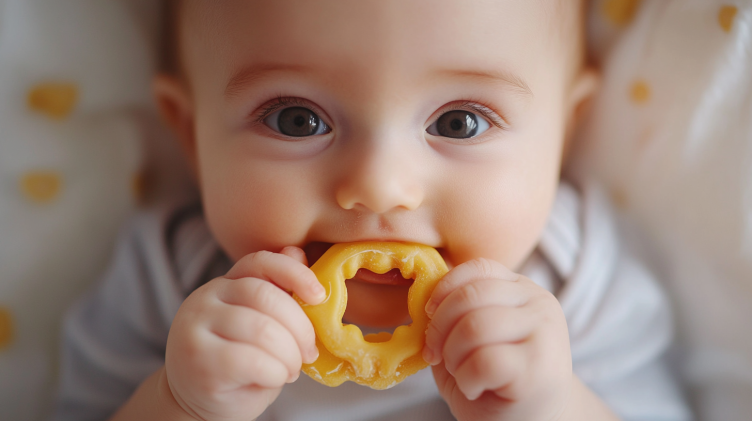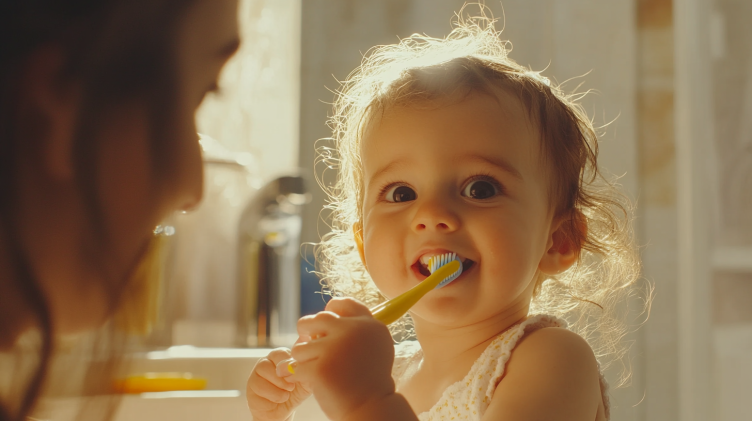Baby teething is both an exciting and challenging journey for parents. Watching your little one transition from a toothless grin to a full set of baby teeth is full of surprises. But do you know what happens during each stage of teething?
Let’s explore the 10 key stages of baby teething so parents can better understand and navigate this milestone with ease.
Stage 1: The Early Teething Signs – Excessive Drooling and Swollen Gums
If you notice your baby suddenly drooling a lot or their gums looking swollen, congratulations—teething has begun!
Babies at this stage may experience some discomfort, such as:
- Constant drooling
- A strong urge to chew on objects
- Increased fussiness and irritability
These early symptoms typically appear between 4 and 6 months.

Tip: Offer soft teething rings to soothe your baby’s gums while ensuring they stay clean and safe.
Stage 2: The First Tooth Appears – “Mom, I Have a Tooth!”
Around 6 months, your baby’s first tooth will likely emerge—usually a lower central incisor. This tiny tooth marks the transition from a gum-only baby to one with a budding smile.
Parents are often thrilled at this milestone, as it signals the start of a new phase in their child’s growth.

Advice: Start using a baby toothbrush and a small amount of fluoride toothpaste to establish good oral hygiene early on.
Stage 3: Lower Front Teeth Start to Fill In
After the first tooth arrives, the lower front teeth typically follow in pairs.
At this point, your baby may start experimenting with solid foods, but chewing might still seem clumsy as they adjust to their new teeth.
Tip: Introduce easy-to-chew foods like mashed vegetables, soft fruit purees, and baby-friendly finger foods.

Stage 4: The Upper Front Teeth Appear – Ready to Bite!
Once the lower teeth are in, the upper front teeth (central incisors) begin emerging. Now, your baby is ready to bite into their favorite foods.
Tip: Offer baby-friendly teething snacks like steamed carrot sticks or teething biscuits to encourage chewing while preventing biting injuries.

Stage 5: The First Molars – Time to Chew Everything!
Around 8 to 10 months, your baby’s first molars start to push through.
This is the peak of the biting phase, where everything becomes a target for chewing—whether it’s a toy, fingers, or even their own tongue!
Tip: Keep an eye on excessive biting and offer teething-safe options to avoid injuries.

Stage 6: The Bigger Molars Emerge – Stronger Chewing Ability
By 12 months, larger primary molars begin emerging. These teeth significantly improve chewing ability, allowing your baby to handle a greater variety of textures in their diet.
Reminder: Avoid sugary snacks to protect these new teeth from tooth decay.

Stage 7: The Upper Molars Follow – The Second Wave of Big Teeth
By 18 months, the upper molars begin to emerge, making chewing even more effective. With both upper and lower molars, babies transition to more complex eating habits.
Advice: Start encouraging your baby to use spoons and forks to develop self-feeding skills.

Stage 8: The Canines Appear – Completing the Front Teeth
Around 2 years old, the canines (pointed teeth) start appearing. These teeth complete the front dental arch, giving your baby a more mature look.
Tip: As more teeth come in, maintaining oral hygiene becomes essential. Brush your baby’s teeth twice daily and introduce the flossing routine.

Stage 9: A Full Set of Baby Teeth Takes Shape
Between 2.5 and 3 years, all 20 primary teeth should be in place, forming a complete baby dental arch.
At this stage, your child can now chew food more efficiently and eat a balanced diet with fewer restrictions.
Tip: Continue monitoring your child’s teeth for any signs of cavities and ensure they have a balanced diet.

Stage 10: The Complete “Tooth Kingdom” – A Full Set of Baby Teeth!
By age 3, your baby will have a full set of 20 baby teeth. These teeth will remain until they start falling out around age 6, making way for permanent teeth.
Reminder: Encourage a healthy diet and good oral hygiene practices to keep their teeth strong. Establishing regular dental visits will also help ensure proper tooth development.

Final Thoughts: Every Stage Matters!
Although the teething process may seem long, each stage plays a vital role in your baby’s oral development.
By understanding these milestones, parents can provide the right care, relief, and nutrition to make the teething journey smoother.
A happy, well-cared-for smile today lays the foundation for strong, healthy teeth in the future!



















